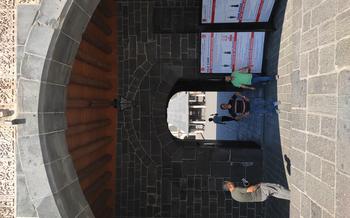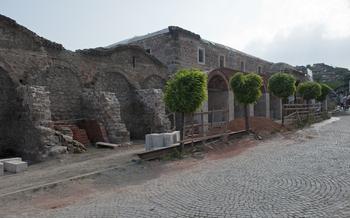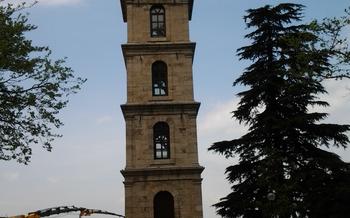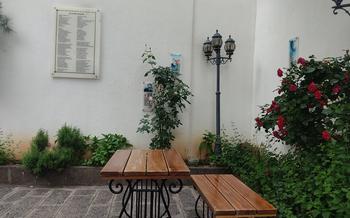
Niksar Historical Stone Bridge
- The Antiquity of Niksar Historical Stone Bridge
- Architectural Marvel
- Strategic Significance
- Resilience Against Nature
- Witness to History
- Exploring the Niksar Historical Stone Bridge
- Panoramic Views
- Local Cuisine and Handicrafts
- Nearby Attractions
- Preservation Efforts
- UNESCO World Heritage Status
- Cultural Significance
- Promoting Sustainable Tourism
- Insider Tip: Unveiling the Magic of the Niksar Festival
The Antiquity of Niksar Historical Stone Bridge
The Niksar Historical Stone Bridge stands as a testament to the rich history and cultural heritage of Turkey. Its story begins in the ancient city of Neocaesarea, established in the 3rd century BC by King Mithridates VI of Pontus. As a major trading hub along the Silk Road, Neocaesarea thrived, and the bridge served as a vital link, facilitating the movement of goods and people between the East and the West.
The bridge's strategic importance continued throughout antiquity. It witnessed the rise and fall of empires, including the Romans, Byzantines, and Seljuks, each leaving their mark on the structure. Over time, the bridge became a symbol of resilience, enduring invasions, earthquakes, and the passage of countless travelers, pilgrims, and merchants.
One remarkable anecdote recounts how the bridge miraculously survived the catastrophic earthquake of 1939 that devastated the region. While buildings and infrastructure crumbled, the bridge remained intact, a testament to the ingenuity of its ancient builders.
Architectural Marvel
The Niksar Historical Stone Bridge stands as an architectural marvel, showcasing unique construction techniques that blend Roman and Byzantine influences. Its remarkable arches, built using ancient engineering principles, have allowed the bridge to withstand the test of time. The bridge's design seamlessly integrates with the surrounding landscape, creating a harmonious balance between human ingenuity and natural beauty. Its enduring presence and architectural significance make it a true masterpiece of ancient engineering and a testament to the skill and artistry of its builders.
Strategic Significance
The Niksar Historical Stone Bridge held immense strategic significance throughout history. Its location along the Tokat-Erzincan-Erzurum trade route made it a critical point for controlling the flow of goods and people between the Black Sea region and the eastern provinces of Anatolia. The bridge enabled armies to cross the river swiftly, ensuring their dominance over the region. Furthermore, it facilitated the transportation of essential supplies and resources, contributing to the economic prosperity of the city. During times of conflict, the bridge served as a defensive barrier, protecting Niksar from enemy incursions. Its strategic value is evident from the numerous historical battles and sieges that took place in its vicinity, highlighting its role as a key military stronghold.
Resilience Against Nature
The Niksar Historical Stone Bridge stands as a testament to the ingenuity and resilience of its ancient builders. Constructed to withstand the ravages of nature, the bridge has endured countless earthquakes, floods, and natural disasters throughout its existence. Its strategic location in a seismically active region posed a significant challenge, yet the bridge's foundations remain solid, a testament to the advanced engineering techniques employed during its construction.
Ancient engineers employed innovative methods to ensure the bridge's stability, such as using interlocking stone blocks without mortar, a technique that allowed for flexibility during seismic activity. The bridge's multiple arches, each designed to distribute weight evenly, further enhanced its ability to withstand earthquakes. These remarkable construction techniques have allowed the bridge to outlast many other structures in the region, demonstrating the skill and foresight of its builders.
Despite its age, the bridge has also shown remarkable resilience against floods. The Tokat River, known for its seasonal flooding, has repeatedly threatened the bridge's foundations. However, the bridge's elevated design and sturdy construction have enabled it to withstand the river's powerful currents and debris.
The Niksar Historical Stone Bridge's survival through centuries of natural disasters is a testament to the builders' mastery of engineering and their commitment to creating a lasting structure. It serves as a reminder of the ingenuity and resilience of ancient civilizations and continues to stand as a symbol of strength and perseverance in the face of nature's challenges.
Witness to History
The Niksar Historical Stone Bridge has stood as a silent observer to the countless historical events that have unfolded over the centuries. Caravans laden with exotic goods from distant lands, armies marching to conquer or defend, and travelers from all walks of life have crossed this bridge, leaving their footprints on the pages of history.
The bridge has witnessed the rise and fall of empires, the ebb and flow of trade and cultural exchange, and the evolution of civilizations. It has seen battles fought, treaties signed, and destinies shaped. Each stone bears the weight of these historical moments, whispering tales of intrigue, adventure, and human endeavor.
As you stand on the bridge, close your eyes and let your imagination transport you back in time. Picture the bustling activity of merchants haggling over prices, the clatter of horseshoes on the cobblestones, and the distant sound of drums signaling the approach of an army. Feel the excitement and anticipation of travelers embarking on new journeys, their hearts filled with dreams and aspirations.
The Niksar Historical Stone Bridge is not just a structure; it is a living testament to the rich tapestry of human history. It is a reminder that even the most enduring landmarks are subject to the relentless passage of time, yet they continue to stand as symbols of our shared heritage and the enduring spirit of humanity.
Exploring the Niksar Historical Stone Bridge
Tips for an Unforgettable Visit:
To fully appreciate the grandeur of the Niksar Historical Stone Bridge, it's essential to plan your visit carefully. Here are some tips to ensure a memorable experience:
-
Timing is Everything: The best time to visit the bridge is during the golden hours, just before sunset. The warm hues of the setting sun cast a magical glow on the ancient structure, creating a picture-perfect moment.
-
Capture the Beauty: Don't forget your camera! The bridge offers endless opportunities for stunning photographs. Experiment with different angles and perspectives to capture its grandeur and the picturesque surroundings.
-
Local Expertise: Consider hiring a local guide for a deeper understanding of the bridge's history and significance. Guides can provide insights into the construction techniques, anecdotes, and local legends associated with the bridge, enriching your visit.
-
Embrace the Surroundings: Take some time to explore the area surrounding the bridge. Wander along the riverbanks, admire the local architecture, and soak in the tranquil atmosphere. You might even stumble upon hidden gems that reveal the city's rich past.
Panoramic Views
The Niksar Historical Stone Bridge offers breathtaking vistas that will leave you in awe. Standing atop this architectural marvel, you'll be treated to a panoramic view of the city and its surroundings. The bridge serves as an exceptional vantage point, allowing you to observe the cityscape and the natural scenery that envelops it. From this elevated position, you can capture stunning photographs that will serve as lasting memories of your visit. Whether you're a seasoned photographer or simply someone who appreciates the beauty of a landscape, the Niksar Historical Stone Bridge is the perfect place to indulge your passion.
Local Cuisine and Handicrafts
Tokat offers a rich culinary experience, and exploring local eateries near the bridge is a must. Sample traditional dishes like Tokat kebab, a succulent lamb dish cooked over an open fire, or Tokat güveç, a hearty stew made with lamb, vegetables, and yogurt. Indulge in local sweets such as Tokat tulum peyniri, a unique cheese aged in goatskin, or Tokat baklavası, a flaky pastry filled with nuts and honey.
Shopping for local handicrafts is a delightful way to support the local economy and take home a piece of Tokat's charm. Discover intricate silver jewelry, hand-woven carpets, and beautiful pottery in the shops near the bridge. Haggle with the friendly vendors and find unique souvenirs that reflect the region's rich cultural heritage. Remember, supporting local businesses not only ensures the sustainability of traditional crafts but also contributes directly to the community's well-being.
Nearby Attractions
Beyond the Niksar Historical Stone Bridge, Tokat is home to a wealth of other captivating historical sites that beckon exploration. Embark on a journey through time as you delve into the ancient city of Tokat Castle, where towering walls and remnants of the past paint a vivid picture of bygone eras. Marvel at the architectural splendor of the Gök Medrese, a theological school adorned with intricate carvings and vibrant tiles. Discover the secrets of the Armenian Church, a testament to the region's rich cultural diversity.
Venture off the beaten path to uncover hidden gems that reveal the essence of Tokat. Explore the picturesque villages nestled amidst rolling hills, where time seems to stand still. Immerse yourself in the vibrant colors and flavors of the local markets, where vendors display an array of traditional handicrafts and fresh produce. Engage with the warm and welcoming locals who are always eager to share stories and insights into their unique way of life.
Preservation Efforts
The Niksar Historical Stone Bridge stands as a testament to the enduring legacy of ancient engineering and architecture. Preserving this iconic landmark is of paramount importance to ensure its survival for generations to come. Local authorities, in collaboration with cultural heritage organizations, have undertaken meticulous restoration and maintenance initiatives to safeguard the bridge's structural integrity and historical authenticity. These efforts involve regular inspections, repairs, and cleaning to mitigate the effects of time and environmental factors.
The local community plays a vital role in the preservation of the bridge. Residents and volunteers participate in awareness campaigns to educate and engage the public in the significance of this historical treasure. By fostering a sense of ownership and pride, the community ensures that the bridge remains a cherished symbol of their heritage.
Preservation efforts extend beyond physical restoration to include the documentation and study of the bridge's history, architecture, and cultural significance. Scholars, historians, and archaeologists conduct research to unravel the mysteries surrounding its construction, use, and evolution over the centuries. This knowledge contributes to a deeper understanding of the bridge's place in the broader context of Turkish and world history.
UNESCO World Heritage Status
The Niksar Historical Stone Bridge possesses exceptional universal value, meeting several criteria for inclusion on the UNESCO World Heritage List. Its unique architectural features, historical significance, and resilience against natural disasters make it a remarkable example of cultural heritage. The bridge showcases the fusion of Roman and Byzantine architectural techniques, demonstrating the rich cultural exchange and technological advancements of its time. Furthermore, its strategic location along the Silk Road and its role in facilitating trade and cultural exchange contribute to its global significance.
Advocating for the bridge's recognition as a UNESCO World Heritage Site would not only raise its profile on the international stage but also provide opportunities for increased funding and support for its preservation and conservation. This recognition would serve as a testament to the bridge's outstanding value and its contribution to world history and architecture. By promoting the bridge's global significance, we can ensure its legacy is preserved for future generations to appreciate and learn from.
Cultural Significance
The Niksar Historical Stone Bridge stands as a testament to the rich cultural heritage of Turkey. Its enduring presence speaks volumes about the architectural prowess of its builders, showcasing their mastery of engineering and design. The bridge's resilience against the ravages of time and natural disasters further cements its significance as a symbol of continuity and strength. For the local community, the bridge is a source of immense pride, embodying their cultural identity and serving as a reminder of their ancestors' remarkable achievements.
Promoting Sustainable Tourism
As responsible travelers, we must strive to minimize our environmental impact and support the local community. Opt for local transportation, such as buses or taxis, to reduce carbon emissions. Respect the cultural norms and traditions of the region, and dress modestly when visiting religious sites. By choosing locally-owned restaurants, shops, and tour guides, you directly contribute to the economic well-being of the community. Sustainable tourism ensures that future generations can continue to appreciate and benefit from the Niksar Historical Stone Bridge and other cultural treasures.
Insider Tip: Unveiling the Magic of the Niksar Festival
To fully immerse yourself in the history and cultural significance of the Niksar Historical Stone Bridge, plan your visit during the annual Niksar Festival. This vibrant celebration, held every year in the city of Niksar, transforms the bridge into a stage for a captivating display of Turkish heritage.
During the festival, the bridge becomes a focal point of traditional dances, music, and crafts demonstrations. Visitors are treated to a mesmerizing showcase of local talent, with traditional costumes, lively rhythms, and intricate handiwork taking center stage. The atmosphere is electric as the city comes alive with the spirit of festivity.
Beyond the performances, the festival offers a unique opportunity to delve into the local culture. Visitors can explore stalls showcasing traditional Turkish handicrafts and savor the flavors of local cuisine, indulging in culinary delights that reflect the region's rich culinary traditions. By supporting local businesses and initiatives, visitors contribute to the preservation of traditional practices and the sustainability of the local economy.
The Niksar Festival is not just a celebration; it's an invitation to experience the living heritage of Tokat and its people. As you witness the bridge adorned with colorful decorations, the air filled with music and laughter, you'll discover a hidden gem of Turkish culture waiting to be explored. Embrace the festival's vibrant energy, let the spirit of Niksar captivate you, and create memories that will last a lifetime.









